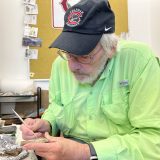
2020 Faculty Opportunity Fund Awardees in Schmid College
June 10, 2020
On Friday, June 5th the Offices of the President, the Provost, and the Vice President for Research announced the recipients of the 2020 Faculty Opportunity Funds. The Faculty Opportunity Fund program was established to support faculty in the development of new and innovative research, scholarship, and creative activity.
Out of 38 proposal submissions, 14 were awarded. Schmid College received the most awards with 4 of our research team projects selected. Learn more below about the research projects that were chosen.
Congratulations to all those who were awarded!
Faculty Opportunity Fund Awardees in Schmid College
Enhancing Optical Metrology Using Directional Asymmetry of Polarizers ($15,000)
Dr. Jerry LaRue, Assistant Professor of Chemistry
Dr. Justin Dressel, Associate Professor and Program Director of Physics
The interference of laser light with itself has long been used for ultra-sensitive measurements. Small changes in an interference pattern can yield large changes in a visible output signal. This fact has enabled common technologies such as laser-based terrain mapping and speed-detection. Currently, the most sensitive interferometric devices are expensive, physically large, and require extreme control of the environment. Thus, there is considerable interest in developing ultra-sensitive measurement methods with cheaper and smaller components that can augment other experiments. We will explore a novel regime of laser interference that enables extreme sensitivity to small polarization rotations of light using cheap tabletop optical components. The key insight is that a sequence of imperfect optical polarizers with a hitherto unnoticed directional asymmetry can be exploited to amplify small angular rotations of the beam polarization. Such rotations can be caused by a range of physical mechanisms, allowing this project to open the doors to enhance the measurement sensitivity for a diverse set of practical applications. The low-cost of the optical components required to produce these effects make this technique a potentially inexpensive, accessible, and pragmatic alternative to state-of-the-art optical metrology methods.
Testing Hypotheses to Explain Population Decline in the Common Loon ($14,950)
Dr. Walter Piper, Professor of Biological Sciences
Brian Hoover, GCI Postdoc Fellow, Chapman University (Co-PI)
Brenna Gormally, GCI Postdoc Fellow, Chapman University (Co-PI)
Common loons (Gavia immer) are a charismatic, diving bird species that inhabits freshwater lakes in the northern United States and Canada. Using 27 years of field data, Dr. Piper’s team has recently shown that populations of loons are declining in northern Wisconsin, with a 25% decrease in chick mass and a 60% decrease in young adult survival over this time period. The mechanism of this decline, however, remains unknown. This grant will be used to test one hypothesis, namely that the resurgence of bald eagle populations may be contributing to decreases in common loon populations. This is crucial work in order to better inform conservation measures for loons, and to understand inter-species population dynamics, for two species that are of national interest and concern.
Bio-inspiration for the Next Generation of Firefighting Technologies ($15,000)
Dr. Douglas Fudge, Associate Professor of Biological Sciences
One of the more serious effects of human-induced climate change is an increased risk of wildfires. In 2018, the Camp Fire in California claimed the lives of 88 people, destroyed over 10,000 structures, and resulted in damage totaling $16.5 billion. One of the main challenges of fighting wildfires is that they often occur in steep areas that are inaccessible to firefighters and ground equipment, leaving the job to helicopters and fixed wing aircraft, which can drop water from the air. Steep terrain poses an additional problem in that water dropped from above does not remain on the fire for long as it rushes downhill. The project described here will test the idea that the defensive slime of hagfishes, which is an ultra- dilute material containing silk-like protein threads, would be an effective tool in fighting wildfires in steep terrain. The slime evolved to lodge in the gills of predators such as sharks, and it is remarkably effective at catching on objects and slowing the flow of water with very little material. This seed project would test whether hagfish slime is more effective than water alone in extinguishing fires on a slope, and if successful, would provide proof of concept for a larger project aimed at designing new firefighting materials that are inspired by hagfish slime. Dr. Fudge’s approach will be to build standardized fires on a sloped steel frame and assess the ability of a variety of materials to extinguish them.
The Egg as a Tool for Noninvasive Assessment of Welfare ($15,000)
Dr. Patricia C. Lopes, Assistant Professor of Biological Sciences
Dr. Brenna Gormally, GCI Postdoctoral Fellow at Chapman University (Co-PI)
Dr. Lopes is interested in determining the causes and consequences of animal social behavior, with an emphasis on disease transmission. Her research integrates several levels of biological organization, including genes, hormones, the brain, the individual, and ultimately the dynamics of a whole social group. In her work, Dr. Lopes combines field and laboratory manipulations, and makes use of behavioral sensors and tracking technology, as well as a range of molecular and histological techniques. She is passionate about mentoring students in research and helping them achieve their full potential. A lot of her group’s research has been aimed at answering the question “Why do we feel sick?” which couldn’t be more relevant these days. Dr. Lopes shares that the assessment of the welfare of captive animals can still be very subjective. When egg-laying animals are stressed or sick, their physiology can change, and part of those changes gets transferred to the egg. With this grant, Dr. Lopes and her team will test whether eggs can be used as tools to assess welfare in bird facilities.
Cover Photo: Dr. Patricia Lopes presenting her research in a Keck laboratory during the Chapman Family Homecoming Celebration in 2019.

